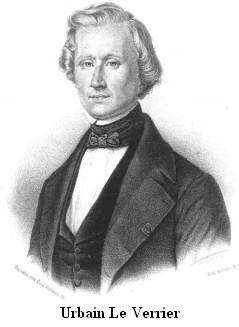¡SkyCaramba! Weekly astronomy blog for the week ending March 29, 2014
 In the 1500s and 1600s, astronomers grew increasingly certain that Earth and the other planets go around the sun. By the early 1700s, mathematics could predict the planets’ positions fairly accurately using a sun-centered model. But in the 1840s, the best observers found that Mercury didn’t move exactly as predicted.
In the 1500s and 1600s, astronomers grew increasingly certain that Earth and the other planets go around the sun. By the early 1700s, mathematics could predict the planets’ positions fairly accurately using a sun-centered model. But in the 1840s, the best observers found that Mercury didn’t move exactly as predicted.
In 1846, astronomer Urbain Le Verrier figured out why Uranus also moved differently than expected. Another planet’s gravity tugged on it. His mathematical analysis led to Neptune’s discovery. Astronomers were sure another planet must be tugging on Mercury. Since nobody ever saw it, they thought it must orbit closer to the sun than Mercury which itself is somewhat hard to see. They hoped to discover it someday when it passed in front of the sun.
One day, someone did see something cross the sun’s disk. A French physician and amateur astronomer, Edmond Lescarbault, thought at first he saw a sunspot. But a sunspot takes several days to cross the sun. It looks like it’s holding still. Lescarbault’s dot crossed the solar disk in an hour and 17 minutes—fast enough that he noticed it moving.
 He wrote a letter to Le Verrier who, since helping find Neptune, had written about a hypothetical intra-Mercurial planet. Le Verrier arranged a visit with Lescarbault during which he asked question after question until he was convinced the doctor had indeed seen what he claimed and had taken the most accurate notes.
He wrote a letter to Le Verrier who, since helping find Neptune, had written about a hypothetical intra-Mercurial planet. Le Verrier arranged a visit with Lescarbault during which he asked question after question until he was convinced the doctor had indeed seen what he claimed and had taken the most accurate notes.
Lescarbault’s observation happened on March 26, 1859. Le Verrier’s visit followed in December. Already in 1860, newly published astronomy books told of a new planet named Vulcan after an ancient god of fire and volcanoes.
Since scientists prefer multiple observations before saying something is confirmed and Lescarbault had made the only observation of Vulcan, many writers expressed doubts. The Handbook of Astronomy by Dionysius Lardner and Edward Dunkin, published in 1860, calls Vulcan “the supposed new inferior planet”. (Please pay attention to supposed rather than inferior which simply means the planet’s orbit is closer to the sun than Earth’s.)
 Le Verrier tried to arrange subsequent observations. From Lescarbault’s details, he calculated an orbit of about 20 days at an inclination of 12°. He also calculated when the planet should transit the sun again. To his and other astronomers’ regrets, it never did. Le Verrier continued believing in the new planet until he died in 1877.
Le Verrier tried to arrange subsequent observations. From Lescarbault’s details, he calculated an orbit of about 20 days at an inclination of 12°. He also calculated when the planet should transit the sun again. To his and other astronomers’ regrets, it never did. Le Verrier continued believing in the new planet until he died in 1877.
Most astronomers now think Lescarbault probably saw a sun-grazing asteroid. Many are now known to whip closely around the sun. However, no one has positively identified one that did on that day in 1859. Also, intense searches with spacecraft built specifically for the purpose haven’t turned up any large enough objects orbiting closer than Mercury. Perhaps the object he saw went into the sun.
So what caused Mercury’s orbit to vary? Albert Einstein provided the answer in his theory of relativity. He explained that very close to a very strong gravity source such as a star, acceleration is noticeably different than physicists had gotten used to. He revised formulae Isaac Newton worked out two centuries previous and produced equations that predicted Mercury’s motion more accurately than ever before.
If someone mentions planet Vulcan now, most people think of the fictional world that’s home to Mr. Spock on Star Trek. But now you will think also of a hypothetical planet central to one diegesis in astronomy history.
¡SkyCaramba!